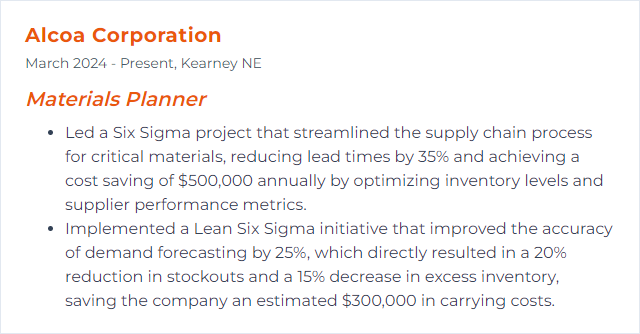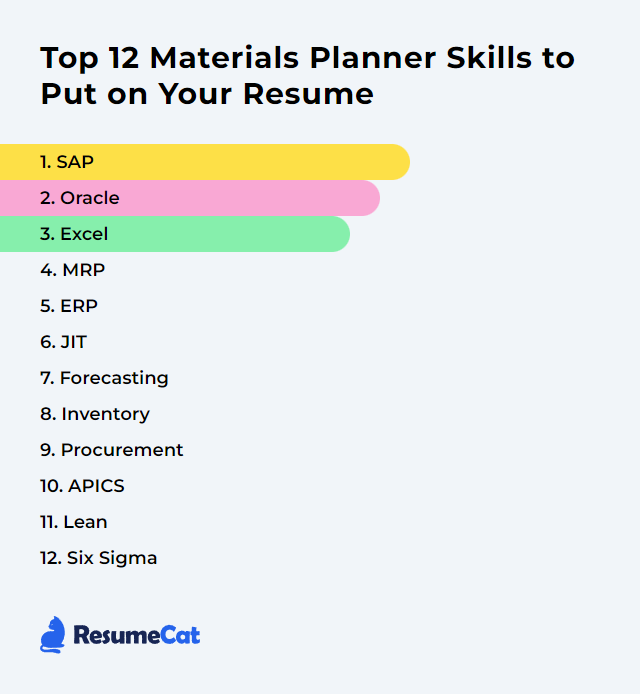Top 12 Materials Planner Skills to Put on Your Resume
In the intricate world of supply chain and production, a Materials Planner keeps the heartbeat steady. Materials in. Products out. Fewer surprises. Showcasing strong skills on your resume signals you can tame variability, read demand before it bites, and keep operations humming with fewer fires and faster turns.
Materials Planner Skills
1. SAP
SAP is an enterprise platform that ties together procurement, inventory, production planning, and distribution so planners see what’s real, what’s late, and what’s next. In many organizations today that means SAP S/4HANA with Fiori apps, plus IBP for planning and, where needed, embedded PP/DS for detailed scheduling.
Why It's Important
It delivers a single source of truth, real-time signals, and automated rules. That means tighter inventory, sharper forecasts, cleaner master data, and faster, more reliable plans.
How to Improve SAP Skills
Make SAP do the heavy lifting, not you:
Harden master data: Treat material masters, BOMs, routings, sourcing, and lead times like gold. Build audits, ownership, and change control.
Tune MRP: Align lot sizing, safety stock methods, coverage profiles, MRP areas, and exception messages to real demand behavior.
Adopt modern planning: Use SAP IBP for demand, supply, and S&OP; use PP/DS in S/4HANA for constraints, sequencing, and pegging where it matters.
Automate decisions: Create alerts, workflows, and job schedules for resupply, parameter reviews, and exception handling.
Use analytics: Build custom CDS views and dashboards for inventory turns, OTIF, planner workload, and forecast error.
Standardize processes: Document planning playbooks and close the loop with regular parameter reviews.
Upskill continuously: Cross-train on MM, PP, SD, and IBP so handoffs are smooth and assumptions are visible.
Get the data right, the parameters smart, and the alerts meaningful—planning becomes calmer and cheaper.
How to Display SAP Skills on Your Resume

2. Oracle
Oracle provides enterprise planning across demand, supply, and inventory. On-prem ASCP is still present in some firms, but most new deployments lean toward Oracle Fusion Cloud Supply Planning and Demand Management.
Why It's Important
It knits together forecasts, constraints, procurement, and production so planners can simulate, commit, and course-correct with fewer blind spots.
How to Improve Oracle Skills
Turn knobs that actually move outcomes:
Clean input signals: BOM accuracy, lead times, supplier calendars, item attributes. Garbage in, volatility out.
Plan scenarios: Use what-if planning for upside/downside, supply constraints, and service-level tradeoffs.
Automate workflows: Set policies for reorder, exception management, and supplier collaboration to cut manual churn.
Tighten collaboration: Share forecasts, commits, and constraints with suppliers and operations on a regular cadence.
Measure relentlessly: Track forecast error, plan adherence, inventory turns, and expedite rates; adjust parameters quarterly.
Cleaner data, better policies, and decisive simulation make Oracle planning systems sing.
How to Display Oracle Skills on Your Resume

3. Excel
Excel is the planner’s Swiss Army knife—fast analysis, ad hoc modeling, quick reconciliation across systems, and simple reports that people actually read.
Why It's Important
For slicing data, checking sanity, and building small tools around the gaps in big systems, nothing is faster.
How to Improve Excel Skills
Level up with features that cut keystrokes and errors:
Modern functions: XLOOKUP, INDEX/MATCH, SUMIFS, FILTER, UNIQUE, LET, LAMBDA—less brittle, more readable.
Pivot mastery: Multi-level pivots, slicers, timelines, calculated fields for rapid inventory and demand diagnostics.
Data integrity: Data validation, structured tables, named ranges, and consistent units.
Power Query: Import, clean, and reshape data from ERP, CSVs, and APIs with repeatable steps.
Power Pivot: Build models with relationships and DAX measures for reusable planning analytics.
Macros (when worthy): Automate repetitive reconciliation and report refreshes with recorded macros or light VBA.
Use spreadsheets for insight, not as a database. Tight models, clear formulas, minimal manual edits.
How to Display Excel Skills on Your Resume
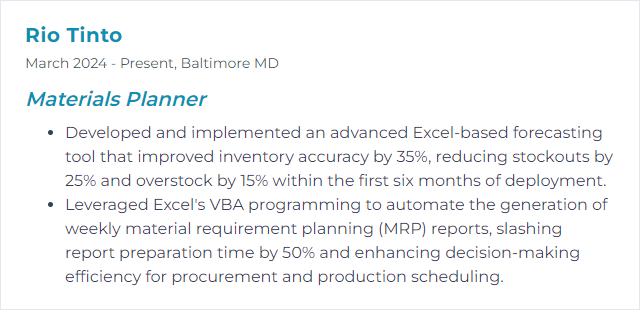
4. MRP
MRP (Material Requirements Planning) determines what to buy and make, and when, based on demand, inventory, BOMs, and lead times. Simple idea, sharp teeth.
Why It's Important
It keeps inventory balanced—enough to protect service, not so much it gathers dust. It schedules supply to match demand without chaos.
How to Improve MRP Skills
Reduce noise; increase signal:
Perfect the inputs: BOM accuracy, realistic lead times, meaningful reorder policies, correct units of measure.
Match policy to demand: Different rules for stable runners, seasonals, and intermittent items (think lot-for-lot vs. fixed lot, safety stock, min/max).
Time fence discipline: Freeze near-term horizons to limit churn; tightly manage changes inside the fence.
Exception focus: Work from prioritized messages (reschedule, cancel, expedite) rather than combing every plan order.
Supplier reliability: Calibrate lead times to actual performance; lock in calendars and capacity expectations.
Continuous improvement: Review plan adherence, expedite volume, and shortages; adjust parameters quarterly.
Professional development: Build depth in planning fundamentals through recognized training and certifications.
Good MRP feels quiet. Fewer surprises, cleaner priorities.
How to Display MRP Skills on Your Resume

5. ERP
ERP (Enterprise Resource Planning) integrates planning with purchasing, inventory, manufacturing, finance, and logistics. It’s the backbone that turns plan into action.
Why It's Important
Planners get real-time visibility, one set of numbers, and streamlined execution from PO to shipment. That means better service at lower cost.
How to Improve ERP Skills
Make the system match how you actually work:
Data discipline: Item masters, suppliers, calendars, and parameters must be clean and current.
Integrations: Connect ERP with MES, WMS, PLM, and EDI so signals flow without rekeying.
Tailored outputs: Build role-based dashboards and alerts for planners, buyers, and schedulers.
Right-sized customization: Configure first. Only customize where the business wins clearly.
Training and SOPs: Standard playbooks, refreshers, and cross-functional drills keep processes tight.
When ERP reflects reality, planning becomes faster and more trustworthy.
How to Display ERP Skills on Your Resume
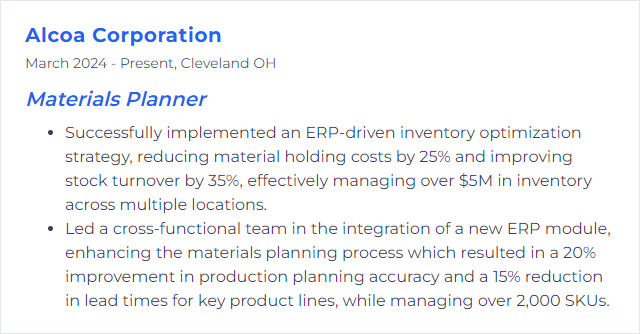
6. JIT
Just-In-Time trims inventory by syncing supply with actual consumption. Less stock lounging on shelves, more flow.
Why It's Important
It lowers carrying costs, exposes problems sooner, and speeds cash cycles—if reliability is strong enough to support it.
How to Improve JIT Skills
JIT needs precision and trust:
Sharper forecasts and signals: Use consumption-based triggers and short feedback loops to catch shifts quickly.
Supplier alignment: Share schedules, stabilize cadence, and set vendor-managed inventory or consignment where it fits.
Lean flow: Kanban, small batches, heijunka (level loading), and standard work reduce variability.
Shorter setup times: SMED and better tooling increase flexibility so you can run smaller lots.
Plan B readiness: Clear playbooks for disruptions—alternate sources, safety buffers, and fast logistics options.
JIT is unforgiving when data or suppliers wobble. Build stability first, then compress.
How to Display JIT Skills on Your Resume

7. Forecasting
Forecasting predicts demand so supply can be ready without waste. For planners, it’s part science, part pattern recognition, part collaboration.
Why It's Important
Better forecasts shrink stockouts and excess, stabilize schedules, and improve supplier performance. Service up, cost down.
How to Improve Forecasting Skills
Make the math and the conversations better:
Segment first: Stable, seasonal, intermittent, and new products need different approaches (think ARIMA, exponential smoothing, Croston for sporadic demand).
Clean the history: Remove stockout bias, one-time promos, and outliers; annotate events for future learning.
Blend signals: Use statistical baselines, sales intelligence, and market inputs; govern changes with clear rules.
Calibrate often: Track MAPE, bias, and service; adjust models, horizons, and granularity quarterly.
Close the loop: S&OP/IBP routines align demand, supply, and finance so the plan is one story, not three.
Forecasts won’t be perfect. They must be useful—and consistently improved.
How to Display Forecasting Skills on Your Resume
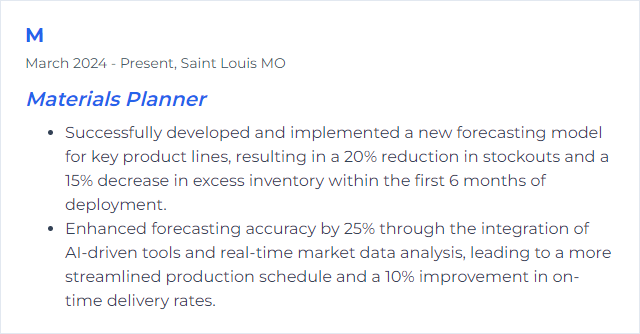
8. Inventory
Inventory is your buffer against uncertainty and your biggest working-capital bet. Get it wrong and you feel it fast.
Why It's Important
The right stock, right place, right time—production flows, customers stay happy, cash isn’t trapped on racks.
How to Improve Inventory Skills
Design inventory with intent:
ABC/XYZ segmentation: Focus effort and service targets by value and variability.
Safety stock math: Use service-level targets, demand variability, and lead-time variation; review after major changes.
Right decoupling: Strategic buffers at bottlenecks and long-lead nodes; avoid sprinkling inventory everywhere.
Cycle counting: Frequent, targeted counts beat annual surprises; fix root causes of discrepancies.
Parameter hygiene: Min/max, reorder points, and lot sizes must reflect reality—recompute, don’t guess.
Obsolescence control: Lifecycle gates, supersession rules, and proactive run-out plans keep scrap low.
Inventory should be purposeful, visible, and always re-earned by data.
How to Display Inventory Skills on Your Resume
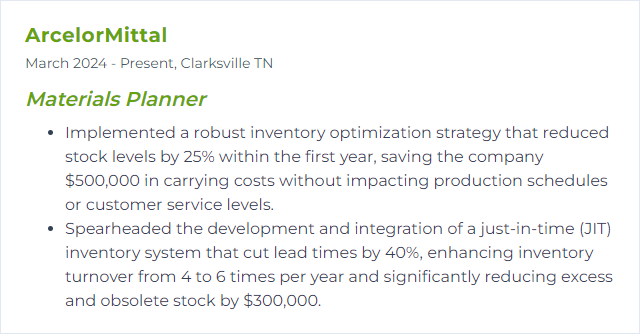
9. Procurement
Procurement secures the materials and services that keep production moving—on time, to spec, at a cost that makes sense.
Why It's Important
Stronger suppliers, fewer expedites, steadier lead times, better cash outcomes. Planning without good procurement is guesswork.
How to Improve Procurement Skills
Build resilience and value, not just price cuts:
Supplier relationship management: Scorecards, QBRs, development plans, and joint forecasting build reliability.
Strategic sourcing: Should-cost estimates, dual sourcing where sensible, and clear risk plans.
Automation: E-sourcing, catalog buys, and touchless POs for routine items free time for strategic work.
Contract clarity: SLAs, penalties, buffers, and review cadences make performance enforceable.
Inventory alignment: Link contracts to min/max, consignment, or VMI to cut working capital and raise service.
Ethics and compliance: Traceability, sustainability goals, and responsible sourcing reduce nasty surprises.
Win with availability, quality, and total cost—together, not separately.
How to Display Procurement Skills on Your Resume
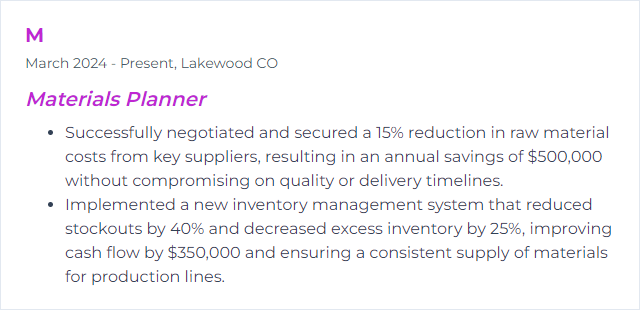
10. APICS
APICS is now part of ASCM (Association for Supply Chain Management). It offers education and respected certifications like CPIM, CSCP, and CLTD that anchor real-world planning practices.
Why It's Important
Shared language, proven methods, stronger decision-making. Certifications also signal credibility and commitment.
How to Improve APICS Skills
Turn learning into better planning:
Pursue certifications: CPIM (production and inventory depth), CSCP (end-to-end supply chain), CLTD (logistics). Note: CPIM has been consolidated into a single-exam format in recent years.
Apply immediately: Bake concepts into SOPs—MRP parameter reviews, S&OP cadence, and root-cause cycles.
Join communities: Local chapters, study groups, and peer roundtables accelerate retention.
Stay current: Refresh knowledge annually; supply dynamics change quickly.
Knowledge sticks when it’s used—tie every concept to a metric you own.
How to Display APICS Skills on Your Resume
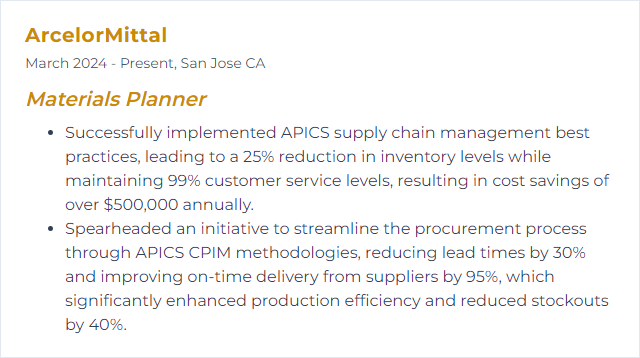
11. Lean
Lean eliminates waste and amplifies value. For planners, that means smoother flow, fewer firefights, and inventory that actually earns its keep.
Why It's Important
Less waiting, rework, and overproduction. More reliability. Better cash and happier customers.
How to Improve Lean Skills
Engineer flow, not just speed:
Visual management: Kanban boards, clear signals, and visible queues so problems surface immediately.
Level loading: Heijunka to stabilize demand on upstream processes; small, consistent batches.
5S and standard work: Order, simplicity, repeatability—fewer mistakes and faster training.
Value Stream Mapping: Map door-to-door; remove delays and handoff friction where they actually occur.
SMED: Shorter changeovers increase flexibility—key for multi-SKU realities.
Kaizen rhythm: Frequent, small improvements beat massive, rare overhauls.
Lean makes variability visible. Then you can kill it—or buffer it consciously.
How to Display Lean Skills on Your Resume
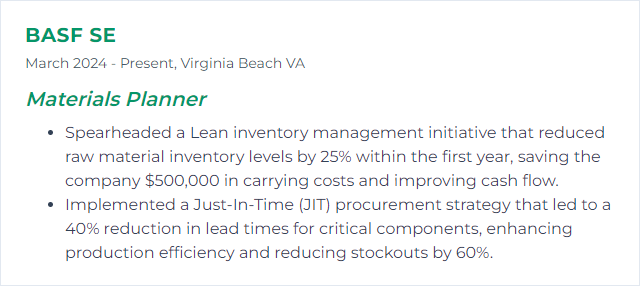
12. Six Sigma
Six Sigma attacks defects and variability with data and structure. DMAIC is the spine: Define, Measure, Analyze, Improve, Control.
Why It's Important
Stable processes boost service, trim cost, and make planning parameters trustworthy. Reliability is a planner’s best friend.
How to Improve Six Sigma Skills
Practical and pointed:
Set crisp goals: Tie projects to measurable outcomes—fill rate, cycle time, scrap, forecast bias.
Measure reality: SPC, control charts, process capability; validate data sources before analysis.
Find root causes: Pareto, fishbone, hypothesis testing; verify before fixing.
Implement targeted fixes: Kanban, poka-yoke, parameter changes, supplier adjustments—small, surgical, fast.
Lock in control: SOPs, control plans, dashboards, and ownership so gains don’t leak away.
Tools and training: Use statistical software where needed; pursue Yellow/Green/Black Belt as your scope grows.
Partner up: Work cross-functionally—quality, manufacturing, suppliers—to accelerate adoption.
The aim is boringly consistent outcomes. That’s where margins widen.
How to Display Six Sigma Skills on Your Resume
